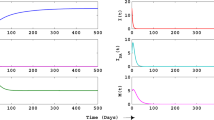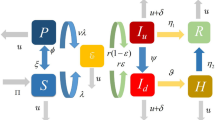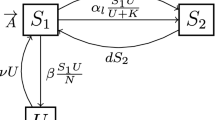Abstract
A problem of theoretical and numerical interest in standard epidemiological models is the calculation or estimation of the basic reproduction number \({\mathcal {R}}_0\). This parameter serves as a threshold quantity for the extinction or spread of the disease. In this paper, we explore a model of drug transmission based on compartmental dynamic models, as in epidemiological models of infectious diseases. The objective is to study \({\mathcal {R}}_0\) as a function of family and public health education. In order to make the general analysis and obtain a wide range of results, we use a fractional time-Caputo derivative instead of the classical time derivative. The analytic and numerical results (existence and uniqueness of solutions, equilibrium stability analysis, parameter sensitivity, trapezoidal rule, and fractional Euler method) showed that the combination of family education and public health has an impact on drug transmission reduction. This can be used to control or adopt treatment strategies.

















Similar content being viewed by others
References
Abidemi A (2022) Optimal cost-effective control of drug abuse by students: insight from mathematical modeling. Model Earth Syst Environ 1:1–19
Ahmed E, El-Sayed A, El-Saka HA (2006) On some Routh–Hurwitz conditions for fractional order differential equations and their applications in Lorenz, RöSsler, Chua and Chen systems. Phys Lett A 358(1):1–4
Akdim K, Ez-Zetouni A, Zahid M (2022) The influence of awareness campaigns on the spread of an infectious disease: a qualitative analysis of a fractional epidemic model. Model Earth Syst Environ 8(1):1311–1319
Ali A, Alshammari FS, Islam S et al (2021) Modeling and analysis of the dynamics of novel coronavirus (Covid-19) with Caputo fractional derivative. Results Phys 20(103):669
Alizadeh S, Baleanu D, Rezapour S (2020) Analyzing transient response of the parallel RCL circuit by using the Caputo–Fabrizio fractional derivative. Adv Differ Equ 2020(1):1–19
Barros LCd, Lopes MM, Pedro FS et al (2021) The memory effect on fractional calculus: an application in the spread of Covid-19. Comput Appl Math 40(3):1–21
Burattini MN, Massad E, Coutinho FAB et al (1998) A mathematical model of the impact of crack-cocaine use on the prevalence of HIV/AIDS among drug users. Math Comput Model 28(3):21–29
Cen X, Feng Z, Zhao Y (2014) Emerging disease dynamics in a model coupling within-host and between-host systems. J Theor Biol 361:141–151
Chitnis N, Hyman JM, Cushing JM (2008) Determining important parameters in the spread of malaria through the sensitivity analysis of a mathematical model. Bull Math Biol 70(5):1272–1296
Diethelm K (2003) Efficient solution of multi-term fractional differential equations using P(EC) m E methods. Computing 71(4):305–319
Din A, Li Y (2020) Controlling heroin addiction via age-structured modeling. Adv Differ Equ 2020(1):1–17
Du M, Wang Z, Hu H (2013) Measuring memory with the order of fractional derivative. Sci Rep 3(1):1–3
Feng Z, Cen X, Zhao Y et al (2015) Coupled within-host and between-host dynamics and evolution of virulence. Math Biosci 270:204–212
Funk S, Salathé M, Jansen VA (2010) Modelling the influence of human behaviour on the spread of infectious diseases: a review. J R Soc Interface 7(50):1247–1256
Ghanbari B, Atangana A (2020) A new application of fractional Atangana–Baleanu derivatives: designing ABC-fractional masks in image processing. Physica A 542(123):516
Hunt LG, Chambers CD et al (1976) The heroin epidemics: a study of heroin use in the United States, 1965–1975, vol 2. Halsted Press, London
Huo J, Zhao H, Zhu L (2015) The effect of vaccines on backward bifurcation in a fractional order HIV model. Nonlinear Anal Real World Appl 26:289–305
Kalula AS, Nyabadza F (2012) A theoretical model for substance abuse in the presence of treatment. S Afr J Sci 108(3):1–12
Lemos-Paião AP, Silva CJ, Torres DF (2017) An epidemic model for cholera with optimal control treatment. J Comput Appl Math 318:168–180
Li J, Ma M (2018) The analysis of a drug transmission model with family education and public health education. Infect Dis Model 3:74–84
Lienard (1914) Sur le signe de la partie réelle des racines d’une équation algébrique. J Math Pures Appl 10:291–346. http://eudml.org/doc/234825
Lin W (2007) Global existence theory and chaos control of fractional differential equations. J Math Anal Appl 332(1):709–726
Liu H (2018) Lyapunov-type inequalities for certain higher-order difference equations with mixed non-linearities. Adv Differ Equ 2018(1):1–14
Liu J, Zhang T (2011) Global behaviour of a heroin epidemic model with distributed delays. Appl Math Lett 24(10):1685–1692
MacKintosh DR, Stewart GT (1979) A mathematical model of a heroin epidemic: implications for control policies. J Epidemiol Commu Health 33(4):299–304
Mukandavire Z, Garira W, Tchuenche J (2009) Modelling effects of public health educational campaigns on HIV/AIDS transmission dynamics. Appl Math Model 33(4):2084–2095
Mulone G, Straughan B (2009) A note on heroin epidemics. Math Biosci 218(2):138–141
Muroya Y, Li H, Kuniya T (2014) Complete global analysis of an sirs epidemic model with graded cure and incomplete recovery rates. J Math Anal Appl 410(2):719–732
Mushanyu J, Nyabadza F, Stewart A (2015) Modelling the trends of inpatient and outpatient rehabilitation for methamphetamine in the western cape province of south africa. BMC Res Notes 8(1):1–13
Naik PA, Yavuz M, Qureshi S et al (2020) Modeling and analysis of Covid-19 epidemics with treatment in fractional derivatives using real data from Pakistan. Eur Phys J Plus 135(10):1–42
Nyabadza F, Hove-Musekwa SD (2010) From heroin epidemics to methamphetamine epidemics: modelling substance abuse in a South African Province. Math Biosci 225(2):132–140
Nyabadza F, Njagarah JB, Smith RJ (2013) Modelling the dynamics of crystal meth (‘TIK’) abuse in the presence of drug-supply chains in South Africa. Bull Math Biol 75(1):24–48
Odibat Z (2006) Approximations of fractional integrals and Caputo fractional derivatives. Appl Math Comput 178(2):527–533
Odibat ZM, Momani S (2008) An algorithm for the numerical solution of differential equations of fractional order. J Appl Math Inform 26(1–2):15–27
Odibat ZM, Shawagfeh NT (2007) Generalized Taylor’s formula. Appl Math Comput 186(1):286–293
Podlubny I (1998) Fractional differential equations: an introduction to fractional derivatives, fractional differential equations, to methods of their solution and some of their applications. Elsevier, London
Resmawan R, Supu N, Achmad N (2021) Dynamic model analysis of the spread of drug addicts with educational effects. In: 1st international conference on mathematics and mathematics education (ICMMEd 2020). Atlantis Press, London, pp 55–64
Saeedian M, Khalighi M, Azimi-Tafreshi N et al (2017) Memory effects on epidemic evolution: the susceptible-infected-recovered epidemic model. Phys Rev E 95(2):022409
Ud Din R, Shah K, Ahmad I et al (2020) Study of transmission dynamics of novel Covid-19 by using mathematical model. Adv Differ Equ 2020(1):1–13
Van den Driessche P, Watmough J (2002) Reproduction numbers and sub-threshold endemic equilibria for compartmental models of disease transmission. Math Biosci 180(1–2):29–48
Vargas-De-León C (2015) Volterra-type Lyapunov functions for fractional-order epidemic systems. Commun Nonlinear Sci Numer Simul 24(1–3):75–85
Wang J, Lv L, Zhou Y (2011) Ulam stability and data dependence for fractional differential equations with Caputo derivative. Electron J Qual Theory Differ Equ 2011(63):1–10
Wang W, Lu S, Tang H et al (2022) A scoping review of drug epidemic models. Int J Environ Res Public Health 19(4):2017
White E, Comiskey C (2007) Heroin epidemics, treatment and ode modelling. Math Biosci 208(1):312–324
Xiang H, Song NN, Huo HF (2016) Modelling effects of public health educational campaigns on drinking dynamics. J Biol Dyn 10(1):164–178
Yang Q, Chen D, Zhao T et al (2016) Fractional calculus in image processing: a review. Fract Calc Appl Anal 19(5):1222–1249
Zeng Q, Cao G, Zhu X (2005) The asymptotic stability on sequential fractional order systems. J Shanghai Jiatong Univ 39(3):346–348
Author information
Authors and Affiliations
Corresponding author
Ethics declarations
Conflict of interest
The authors declare that they have no conflict of interest, contributed equally to this article, and have approved its publication version.
Additional information
Publisher's Note
Springer Nature remains neutral with regard to jurisdictional claims in published maps and institutional affiliations.
Rights and permissions
Springer Nature or its licensor (e.g. a society or other partner) holds exclusive rights to this article under a publishing agreement with the author(s) or other rightsholder(s); author self-archiving of the accepted manuscript version of this article is solely governed by the terms of such publishing agreement and applicable law.
About this article
Cite this article
Alla Hamou, A., Azroul, E., Diki, G. et al. Effect of family and public health education in drug transmission: an epidemiological model with memory. Model. Earth Syst. Environ. 9, 2809–2828 (2023). https://doi.org/10.1007/s40808-022-01662-6
Received:
Accepted:
Published:
Issue Date:
DOI: https://doi.org/10.1007/s40808-022-01662-6




